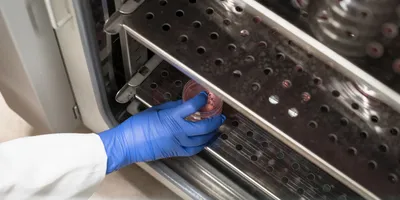Throughout the COVID-19 pandemic, supply chains around the world have struggled. Consequently, science labs and their suppliers adjusted to keep experiments and production going.
“Before the pandemic, lab managers relied on a supplier consolidation strategy for bundling lab spend for—perceived—higher purchasing power and improved efficiency,” says David Pumberger, ZAGENO’s chief strategy officer and cofounder. “Product availability was taken for granted, and single-supplier dependency was not a significant consideration.” To keep a supply chain resilient, Pumberger suggests that labs develop a procurement model that provides “access to products from familiar, trusted brands to emerging suppliers entering the industry with their points of differentiation.” During the COVID-19 pandemic, ZAGENO saw customers ordering earlier to allow more lead time in case something was backordered.
For some suppliers, creativity solved some of the shortages. Although John Viero, vice president, Cole-Parmer Essentials, noticed an increase in the volume and size of orders, as well as some products going out of stock, especially masks and hand sanitizer, he adds: “We have the resourcefulness to manufacture our own hand sanitizer, and this helps to keep product in stock for when our customers need it.” Cole-Parmer manufactures most of its products, which is one way to gain better control over high demand.
Contending with costs
To add to lab managers’ challenges of finding supplies, some items increased significantly in price. In a recent podcast, for example, Michael Norden, head of procurement at The Babraham Institute, noted that the price of nitrile gloves increased by 400 percent over about nine months. “You can’t work in the labs without nitrile gloves,” Norden says. So, a lab’s procurement manager needs to not only find the products in the required quantities, but also at an affordable price.
Enforced flexibility
As expected, labs faced more issues with getting some consumables than others. “Getting plastic consumables and gowning supplies have been the most difficult to stock—understandably—in terms of turnaround times or even estimated delivery dates,” says Erin Thane, vice president at Azzur Labs. “We have had to approve additional smaller vendors that have these stocks.”
To keep a lab supplied as needed with consumables, Thane suggests carefully keeping track of what has been ordered and being open to alternatives. As an example, Thane says, “The smaller local or state-wide vendors have hidden gems of surplus supplies and have been happy to help in any way.”
Viero also encourages customers to plan ahead—even more so than usual. “Don’t wait until you are down to your last box of gloves to place an order for more,” he says. “You don’t want to place yourself in a bind by not being able to get what you need.”
Thane notes that items in limited quantities can be ear marked for specific customers. So, setting up standard orders with a vendor can help. This method does not guarantee getting consumables, but it can increase the odds. “Having standing orders moves you higher up on the priority lists,” Thane says. For non-perishable consumables, Thane encourages labs to order items in bulk when they are available.
Supplying bioprocessors
Industrial trends also impact the need for supplies. In bioprocessing, for example, the evolution toward single-use technology—such as plastic bags instead of stainless-steel tanks—increases the need for consumables. “The demand for materials used for biologics manufacturing has increased over the past five years,” says Till Heidemann, head of global indirect procurement at Lonza, and the main driver is the emphasis on single-use technology. Plus, Heidemann says, “The rapid rise of COVID-19 vaccine development and production has increased that demand faster than capacity.”
Finding new suppliers and keeping stocked took a lot of time and energy at Lonza. “A constrained supply chain for materials—plastic vials, filters, connectors—requires daily management and frequent production plan reshaping,” Heidemann explains. The company had to reschedule programs and communicate closely with suppliers and customers. Plus, in-house communication was key. As Heidemann says, “Fundamental considerations are making sure that the data across the organization allows us to have transparency, and then we can move materials around our network.”
“The smaller local or state-wide vendors have hidden gems of surplus supplies and have been happy to help in any way.”
The challenges in obtaining consumables led Lonza to run a program to transform its supply chain. This program’s primary objective, says Heidemann, is “to bring demand and supply in better balance under better processes.”
On the upswing
The greatest challenges in obtaining lab consumables are starting to ease. “For the most part, in the latter quarter of 2021 and into 2022, we have seen a lot of backordered stock start to come through,” Thane says. “So, things seem to be more available now.”
Still, some of the lessons learned during the COVID-19 pandemic can be applied to stocking labs even in more ordinary times. For example, Pumberger envisions that procurement managers “will no longer put all eggs in one supplier basket.”
It always pays to think ahead, know what a lab will need and when, and keep track of stocked supplies and what has been ordered. Staying in touch with suppliers can also reduce the odds of running out of a crucial consumable. A supplier should be able to forecast any potential supply problems and help a customer plan accordingly. As the COVID-19 pandemic showed, though, some things just can’t be predicted. Consequently, both the suppliers and purchasers of lab consumables need to include a safety factor—aiming a little high rather than low—to keep products available and labs stocked.










